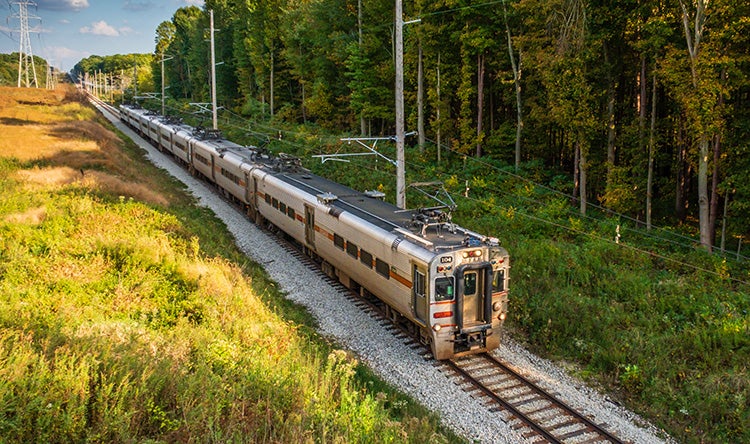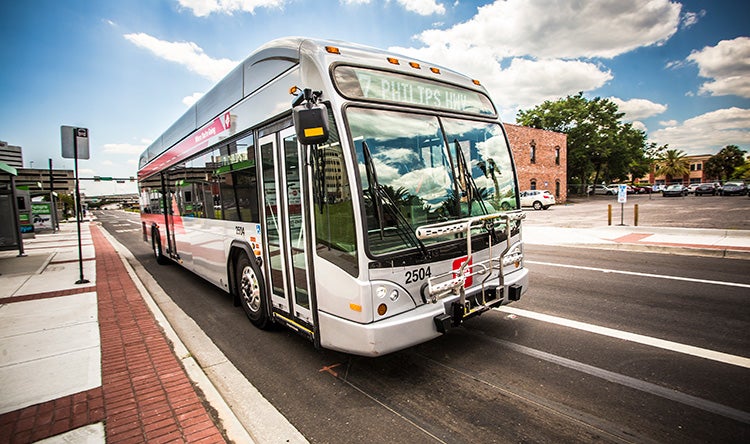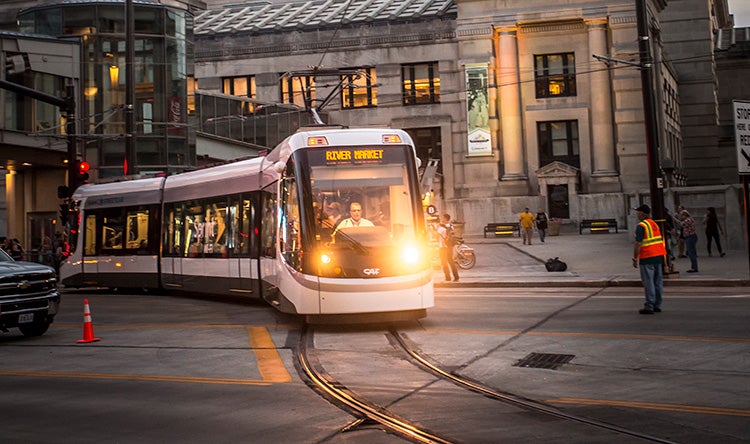
Experts Talk: Transit Capital Investment Grant Funding with Mark Fuhrmann
Experts Talk is an interview series with technical leaders from across our transportation program.
How to Prepare and Successfully Compete for Major U.S. Transit Grants
The Federal Transit Administration’s Capital Investment Grants program dedicates more than $4.5 billion a year to funding investments in heavy rail, commuter rail, light rail, streetcars and bus rapid transit. Competition is high to secure these discretionary funds, with more eligible projects than available funding. U.S. transit agencies interested in tapping this source of funds should begin with a thorough knowledge of the program, its requirements and what will be expected of them.
With more than 30 years of transit experience, Mark Fuhrmann is an expert at delivering successful projects with FTA funding. He most recently helped deliver the FTA grant agreements for the Northern Indiana Commuter Transportation District Double Track Northwest Indiana Project and its West Lake Corridor Project. Before joining HDR in 2018, Fuhrmann led efforts on five New Starts projects while serving as Minneapolis’ Metro Transit’s deputy general manager. In this interview, he explains the Capital Investment Grants, or CIG, program, shares insights on what can help create successful applications, discusses the timeline of projects and describes the biggest hurdles for agencies pursuing these grants.
Transit Capital Investment Grant Funding
Q. What are the basics of this program and its components?
A. While the overall federal program is referred to as the CIG program, there are three main project categories that comprise it:
- New Starts: Projects qualify if they are new fixed guideway rail or BRT systems, or an extension of current system. These grants are for projects whose total cost exceeds $300 million or who are seeking New Starts funding of more than $100 million.
- Small Starts: A smaller version of New Starts, the same project types qualify, but the total project cost is less than $400 million and total Small Starts funding sought is less than $150 million. In addition, corridor-based BRT systems that mostly emulate rail service delivery, those not using a separated right-of-way, are eligible for this category.
- Core Capacity: Rather than new or expanded systems, this category of grants funds corridor-based investments in existing fixed guideway systems. To qualify, projects must be in a corridor that is at capacity or will be within the next 10 years. And the project itself must increase that capacity by at least 10%.

Q. How can agencies benefit from consulting CIG funding specialists?
While the statutory requirements of the program are spelled out in legislation, the program can and does change over time. Agencies that received a grant in the past may find that the process is markedly different than they remember. Experts in the process who work on grants across the nation are up to date on changes as well as nimble and flexible when it comes to new revisions.
In addition, those more familiar with the program understand its practical as well as statutory limits. For example, the federal statute states that FTA can pay up to 60% of the cost of a project seeking a New Starts or Core Capacity grant. But in practice in recent years, FTA grant awards have been closer to half of project cost, some less than 50%. Understanding norms such as these can help dramatically in planning and budgeting.
In the last four years, from 2017 to early 2021, the FTA awarded 34 CIG funding grants, and HDR helped our clients secure 17 of them. With less than 10 grants a year awarded and more than 2,000 transit systems in the U.S., experience and know-how on the CIG program can vary considerably among agencies. Staff turnover, the time interval since an agency’s last major project, staff experience and other factors can impact chances of receiving an award.
Agencies with limited knowledge about the CIG program can benefit from talking with counterparts at other agencies that have pursued grants. They can also benefit from seeking the assistance of consultants who’ve gone through the process with multiple agency clients and can give guidance and advice and help assemble the required FTA documentation.
Q. What is the FTA looking for in successful grant applications?
A. Many factors go into the FTA recommendation for any grant award, including the overall readiness of the project for capital funding, geographic balance of grant awards, the amount of committed funds available as local match, and a project’s overall rating. Each project seeking funds must provide technical project justification that responds to six criteria:
- environmental benefits — dollar value of anticipated direct and indirect benefits to human health, safety, energy and the air quality environment
- congestion relief — number of new weekday linked transit trips resulting from implementation of the project
- land use — quantitative examination of existing corridor and station area development
- economic development — qualitative examination of proposed project’s likelihood to induce additional, transit-supportive development based on existing local plans and policies
- cost effectiveness — annualized capital cost plus operating and maintenance cost per trip on the project
- mobility improvements — total number of linked trips using the project, with a weight of two assigned to passenger trips that would be made by transit dependent persons
The FTA also has a set of financial criteria that projects must meet, showing “evidence of stable and dependable financial sources.” Applicants must first explain how they're going to fund the delivery and construction of the project for which a grant is being sought. The FTA also requires a 20-year financial plan that demonstrates how the transit agency will successfully operate and maintain the new project(s), as well as any base system that might already be in service. This is an area where HDR’s financial experts have excelled in helping our clients. We have helped multiple agencies across the U.S. with their 20-year operating plans, working in close collaboration with their financial, operations & maintenance lead staff.

Q. What parts of the grant application process tend to be most difficult or time-consuming for agencies?
A. Three major parts of the process stand out as the most challenging. First, agencies need to have their financial houses in order. That includes having commitments to pay for the new project and a plan to ensure existing operations are not negatively impacted. Most often the local dollars are not provided solely by the transit agency and typically there are multiple non-federal funding partners that need to make hard financial commitments for their contribution share. Securing board or legislative action to solidify these funding commitments adds time and uncertainty to the process.
Second is the need to negotiate agreements — in some cases fairly complicated ones — with third parties like utilities or the municipalities that the project will pass through. Some projects I've worked on have required agreements with Class I freight railroads that a project will cross over or under or parallel. Patience and fortitude are often required to negotiate agreements with all of these entities to ensure the project can move forward and is ready for construction.
Lastly, the FTA requires an evaluation of not only the financial health of project sponsors, but the breadth and experience of their management with large capital projects. The FTA wants to ensure the project sponsor has the capacity and the capability to take on this new project. This can be challenging for agencies who may be adding a new mode of transit to their service offerings that requires different technical skills to construct, operate and maintain. Do they have a sufficient number of staff to ultimately manage the construction? Once constructed, do they have adequate in-house or contract staff to operate and maintain the project? This is often an area where agencies rely on consultants to deliver their projects, particularly for program t and/or construction management of a project.
Q. Early preparation can make a big difference in applications. What does that preparation look like?
A. Before presenting an application to the FTA to enter the Capital Investment Grants pipeline, a project sponsor should complete three steps to best position a project.
First, conduct early planning and engineering in the project corridor with robust community engagement. This requires 5-10% engineering to ensure the project is physically viable in the corridor and will generate the community benefits expected by the FTA justification criteria.
Second, the FTA wants some confidence that this project has the state and local support to succeed, and so they look to see if the state and local stakeholders are in alignment. Those stakeholders are not merely governmental agencies and regulators, but also i community and business groups, major institutions (academia, health care, etc.) and directly affected third parties. General consensus should be achieved on the project parameters and plan. If the preferred plan prescribes an 8-mile system and 15 stations, there should not be a critical stakeholders saying, “Well, that’s OK, but the only plan we’ll support is 10 miles and 17 stations.”
Soon after a project is approved to enter the Project Development phase, the FTA expects the lead agency will request the metropolitan planning organization to formally adopt the locally preferred alternative into their long-range transportation plan. It can take some time to make sure that all of the stakeholders have the same vision and are in agreement as to what this project ultimately is going to look like. This phase also requires the environmental review be conducted in concert with FTA to identify impacts and develop mitigation actions where necessary.
Third, it is always beneficial to present the project scope and justification to FTA regional and headquarters staff early in the process. This important communication step will clarify the project definition and the resulting benefits that the FTA will expect to review as the project moves along.
Even after a project is initially approved to enter the CIG pipeline, it might need to be presented to new leaders to re-secure its base of support. These are complex, multi-year projects and in some cases, the officials who championed the project initially retire or don’t get re-elected or re-appointed. This can create a need to re-anchor and re-educate some of the stakeholders as a project advances through the phases of the CIG program.

Q. Is there a cycle by which grants are awarded? What schedule should agencies expect? What about timing beyond the initial FTA approval?
A. Traditionally, yes there is an annual cycle. However, the FTA will accept applications for these CIG projects at any time. The FTA has historically set its own rhythm for these projects because they're driven by the development of each annual federal budget. That budget typically comes out in the first half of February, except for years in which a new administration is transitioning.
Backing up from that budget, the FTA typically asks for all of the data such as project rating, project justification and project financials at the end of the previous August. From that submittal, they go through their internal review, conduct their analysis and rate the projects in the FTA Annual CIG Report. The CIG Report is one of many detailed agency reports that are ultimately incorporated into the president's budget request for the following federal fiscal year.
On a wider scale, project backers can expect a long road. Each project has its own characteristics and opportunities, but grant seekers can almost universally expect to be working on these for many years. Generally speaking, once approved to enter project development, under current law, that's a two-year commitment. Next is the engineering phase, which typically takes two to three more years. With HDR’s experience with the CIG program, we know what FTA expects and can minimize the duration of grant readiness prior to the CIG grant.
Then, once an agency has completed project development and engineering, it then secures the grants to build the project. Depending on the scope of the project, this usually takes another three, four or more years.
So, from the start of the FTA saying, “Yes, this project has merit and yes, we will partner with you to bring it through to implementation,” it can be upward of seven or eight years to ribbon cutting. On one of my past projects, we were approved to start project development in 2010. And right now, the project is scheduled to open in 2024. My kids were just starting grade school when we got the OK to start the project and it looks like my kids are going to be in college when the project opens for service. HDR has the experience and expertise to provide the continuity needed over the long haul to support project sponsors successfully making these projects a reality.
Inspiration & Advice
What do you appreciate about your role helping guide transit projects?
It's tremendously gratifying to see a project go from a line on a map to a design desk, to construction and then to a ribbon cutting when thousands can then get on a train or bus knowing they have much improved access to opportunities, whether it’s a job or classes at the university or a medical appointment. That is what is so motivating about what we do at HDR, we make great things happen! We can provide that enhanced mobility for thousands and thousands of people with these transit investments.
It's very, very motivating for me because I know that there's more work to do to move that next project forward to fruition.
What advice do you have for someone just starting out in transit?
Applicable to all who are starting out, learn the basics of transit and understand the interplay between all the skill disciplines needed to deliver a transit project and service. This knowledge can then be shared when dealing with community stakeholders and policy-makers to transform a project from concept to construction to ribbon-cutting, benefitting thousands with greater mobility.
Each Experts Talk interview illuminates a different aspect of transportation infrastructure planning, design and delivery. Sign up to receive email updates whenever new insights are published from the specialized experts and thought leaders behind our award-winning, full service consulting practice.




